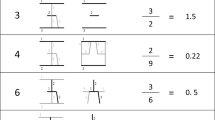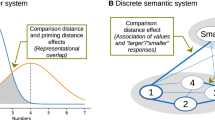Abstract
Higher-level mathematics requires a connection between literal symbols (e.g., ‘x’) and their mental representations. The current study probes the nature of mental representations for literal symbols using both the priming distance effect, in which ease of comparing a target number to a fixed standard is a function of prime-target distance, and the comparison distance effect, in which ease of comparing two numbers depends on the distance between them. Can literal symbols that have been assigned magnitude access mental representations of quantity to produce distance effects? Forty participants completed number comparison tasks involving Arabic numerals and literal symbols, a training task, and a working memory task. While both distance effects were present with Arabic numerals, there was no evidence of either with literal symbols. Results suggest that literal symbols may not share the same mental representations of magnitude as other number formats or may access them differently. Additional research is needed to understand mental representations utilized in higher-level mathematics (e.g., algebra), which includes both Arabic numerals and literal symbols.







Similar content being viewed by others
Notes
The meaning of an Arabic numeral could be dependent on its place-value (e.g., 3, 30, 0.03). However, above we refer to the Arabic numeral as a whole, rather than the role of individual digits.
For brevity, we do not report the CDE for the Arabic numerals only condition or pairwise comparisons for each distance related to error rate and reaction time. Results are available from the authors by request.
References
Ansari, D. (2008). Effects of development and enculturation on number representation in the brain. Nature Reviews Neuroscience, 9(4), 278–291. doi:10.1038/nrn2334.
Bardini, C., Radford, L., & Sabena, C. (2005). Struggling with variables, parameters, and indeterminate objects or, how to go insane in mathematics. In Proceedings of the 29th Conference of the International Group for the Psychology of Mathematics Education (Vol. 2, pp. 129–136). Melbourne, Australia.
Bartelet, D., Vaessen, A., Blomert, L., & Ansari, D. (2014). What basic number processing measures in kindergarten explain unique variability in first-grade arithmetic proficiency? Journal of Experimental Child Psychology, 117, 12–28. doi:10.1016/j.jecp.2013.08.010.
Booth, L. (1999). Children’s difficulties in beginning algebra. Algebraic thinking, grades K-12: Readings from the NCTM’s school-based journals and other publications (pp. 299–307). National Council of Teachers of Mathematics: Reston, VA.
Christou, K. P., & Vosniadou, S. (2005). How students interpret literal symbols in algebra: a conceptual change approach. In Proceedings of the XXVII Annual Conference of the Cognitive Science Society (Vol. Italy, pp. 453–458).
Cohen Kadosh, R., & Walsh, V. (2009). Numerical representation in the parietal lobes: abstract or not abstract? Behavioral and Brain Sciences, 32(3–4), 313. doi:10.1017/S0140525X09990938.
De Smedt, B., Verschaffel, L., & Ghesquière, P. (2009). The predictive value of numerical magnitude comparison for individual differences in mathematics achievement. Journal of Experimental Child Psychology, 103(4), 469–479. doi:10.1016/j.jecp.2009.01.010.
Defever, E., Sasanguie, D., Gebuis, T., & Reynvoet, B. (2011). Children’s representation of symbolic and nonsymbolic magnitude examined with the priming paradigm. Journal of Experimental Child Psychology, 109(2), 174–186. doi:10.1016/j.jecp.2011.01.002.
Dehaene, S. (1997). The number sense: how the mind creates mathematics. New York: Oxford University Press.
Dehaene, S., & Akhavein, R. (1995). Attention, automaticity, and levels of representation in number processing. Journal of Experimental Psychology. Learning, Memory, and Cognition, 21(2), 314–326.
Dehaene, S., Naccache, L., Le Clec’H, G., Koechlin, E., Mueller, M., Dehaene-Lambertz, G., Le Bihan, D. (1998). Imaging unconscious semantic priming. Nature, 395(6702), 597–600. doi:10.1038/26967.
den Heyer, K., & Briand, K. (1986). Priming single digit numbers: automatic spreading activation dissipates as a function of semantic distance. The American Journal of Psychology, 99(3), 315–340. doi:10.2307/1422488.
Fias, W., van Dijck, J.-P., & Gevers, W. (2011). Chapter 10—How is Number Associated with Space? The Role of Working Memory. In S. Dehaene & E. M. Brannon (Eds.), Space, Time and Number in the Brain (pp. 133–148). San Diego: Academic Press. Retrieved from http://www.sciencedirect.com/science/article/pii/B9780123859488000104.
Ganor-Stern, D., & Tzelgov, J. (2008). Across-notation automatic numerical processing. Journal of Experimental Psychology. Learning, Memory, and Cognition, 34(2), 430–437. doi:10.1037/0278-7393.34.2.430.
Holloway, I. D., & Ansari, D. (2008). Domain-specific and domain-general changes in children’s development of number comparison. Developmental Science, 11(5), 644–649. 10.1111/j.1467-7687.2008.00712.x.
Kieran, C. (2007). Learning and teaching of algebra at the middle school through college levels: building meaning for symbols and their manipulation. In F. K. Lester (Ed.), Second Handbook of Research on Mathematics Teaching and Learning (2nd ed., pp. 707–762). Charlotte: Information Age Pub.
Koechlin, E., Naccache, L., Block, E., & Dehaene, S. (1999). Primed numbers: exploring the modularity of numerical representations with masked and unmasked semantic priming. Journal of Experimental Psychology: Human Perception and Performance, 25(6), 1882–1905. doi:10.1037/0096-1523.25.6.1882.
Küchemann, D. E. (1981). Algebra. Children’s understanding of mathematics: 11-16 (pp. 82–87). London: Athenaeum Press Ltd.
Lyons, I. M., & Ansari, D. (2009). The cerebral basis of mapping nonsymbolic numerical quantities onto abstract symbols: an fmri training study. Journal of Cognitive Neuroscience, 21(9), 1720–1735.
McNeil, N. M., Weinberg, A., Hattikudur, S., Stephens, A. C., Asquith, P., Knuth, E. J., & Alibali, M. W. (2010). A is for apple: mnemonic symbols hinder the interpretation of algebraic expressions. Journal of Educational Psychology, 102(3), 625–634. doi:10.1037/a0019105.
Moyer, R. S., & Landauer, T. K. (1967). Time required for judgments of numerical inequality. Nature, 215(5109), 1519–1520.
Naccache, L., & Dehaene, S. (2001). Unconscious semantic priming extends to novel unseen stimuli. Cognition, 80(3), 215–229.
Nie, B., Cai, J., & Moyer, J. (2009). How a standards-based mathematics curriculum differs from a traditional curriculum: with a focus on intended treatments of the ideas of variable. ZDM—The International Journal on Mathematics Education, 41(6), 777–792. doi:10.1007/s11858-009-0197-1.
Peirce, J. W. (2007). PsychoPy—Psychophysics software in Python. Journal of Neuroscience Methods, 162(1–2), 8–13. doi:10.1016/j.jneumeth.2006.11.017.
Philipp, R. A. (1992). A study of algebraic variables: beyond the student-professor problem. Journal of Mathematical Behavior, 11(2), 161–176.
Philipp, R. (1999). The many uses of algebraic variables. Algebraic thinking, grades K-12: Readings from the NCTM’s school-based journals and other publications (pp. 157–162). National Council of Teachers of Mathematics: Reston, VA.
Restle, F. (1970). Speed of adding and comparing numbers. Journal of Experimental Psychology, 83(2, Pt.1), 274–278. http://doi.org/10.1037/h0028573.
Reynvoet, B., Brysbaert, M., & Fias, W. (2002a). Semantic priming in number naming. The. Quarterly Journal of Experimental Psychology. A, Human Experimental Psychology, 55(4), 1127–1139. doi:10.1080/02724980244000116.
Reynvoet, B., Caessens, B., & Brysbaert, M. (2002b). Automatic stimulus-response associations may be semantically mediated. Psychonomic Bulletin & Review, 9(1), 107–112.
Reynvoet, B., De Smedt, B., & Van den Bussche, E. (2009). Children’s representation of symbolic magnitude: the development of the priming distance effect. Journal of Experimental Child Psychology, 103(4), 480–489. doi:10.1016/j.jecp.2009.01.007.
Rosnick, P. (1982). Students’ symbolization processes in algebra. Retrieved July 29, 2014. http://search.ebscohost.com/login.aspx?direct=true&db=eric&AN=ED300230&site=ehost-live&scope=site.
Sasanguie, D., Göbel, S. M., Moll, K., Smets, K., & Reynvoet, B. (2013). Approximate number sense, symbolic number processing, or number–space mappings: what underlies mathematics achievement? Journal of Experimental Child Psychology, 114(3), 418–431. doi:10.1016/j.jecp.2012.10.012.
Schoenfeld, A. H., & Arcavi, A. (1999). On the meaning of variable. Algebraic thinking, grades K-12: Readings from the NCTM’s school-based journals and other publications (pp. 150–156). National Council of Teachers of Mathematics: Reston, VA.
Trigueros, M., & Ursini, S. (2003). First-year undergraduates’ difficulties in working with different uses of variable. In Research in collegiate mathematics education, Volume 5 (pp. 1–29). Providence, RI: American Mathematical Society. Retrieved July 29, 2014, from http://books.google.com/books?id=foJJvXneF5sC&lpg=PA1&ots=xKHM66djYv&dq=ursini%2C%20sonia%2C%20algebra&lr&pg=PA1#v=onepage&q=ursini,%20sonia,%20algebra&f=false.
Unsworth, N., Redick, T. S., Heitz, R. P., Broadway, J. M., & Engle, R. W. (2009). Complex working memory span tasks and higher-order cognition: a latent-variable analysis of the relationship between processing and storage. Memory, 17(6), 635–654. doi:10.1080/09658210902998047.
Usiskin, Z. (1999). Conceptions of school algebra and uses of variables. Algebraic thinking, grades K-12: Readings from the NCTM’s school-based journals and other publications (pp. 7–13). National Council of Teachers of Mathematics: Reston, VA.
Van Dijck, J.-P., & Fias, W. (2011). A working memory account for spatial–numerical associations. Cognition, 119(1), 114–119. doi:10.1016/j.cognition.2010.12.013.
Van Dijck, J.-P., Gevers, W., & Fias, W. (2009). Numbers are associated with different types of spatial information depending on the task. Cognition, 113(2), 248–253. doi:10.1016/j.cognition.2009.08.005.
Van Opstal, F., Gevers, W., De Moor, W., & Verguts, T. (2008). Dissecting the symbolic distance effect: comparison and priming effects in numerical and nonnumerical orders. Psychonomic Bulletin & Review, 15(2), 419–425. doi:10.3758/PBR.15.2.419.
Verguts, T., & Fias, W. (2004). Representation of number in animals and humans: a neural model. Journal of Cognitive Neuroscience, 16(9), 1493–1504. doi:10.1162/089892904256849.
Verguts, T., Fias, W., & Stevens, M. (2005). A model of exact small-number representation. Psychonomic Bulletin & Review, 12(1), 66–80.
Acknowledgments
We thank Dr. Gigi Luk for her assistance with research design, analysis, and feedback on previous versions of this manuscript. We also thank Dr. Kurt Fischer, George Spencer, Janine de Novais, and three anonymous reviewers for feedback on prior versions of this manuscript. This research was funded by the Graduate Student Award from the Mind, Brain, Behavior Interfaculty Initiative at Harvard University to CP and the Harvard Graduate School of Education Dean’s Summer Fellowship to CP.
Author information
Authors and Affiliations
Corresponding author
Rights and permissions
About this article
Cite this article
Pollack, C., Leon Guerrero, S. & Star, J.R. Exploring mental representations for literal symbols using priming and comparison distance effects. ZDM Mathematics Education 48, 291–303 (2016). https://doi.org/10.1007/s11858-015-0745-9
Accepted:
Published:
Issue Date:
DOI: https://doi.org/10.1007/s11858-015-0745-9




